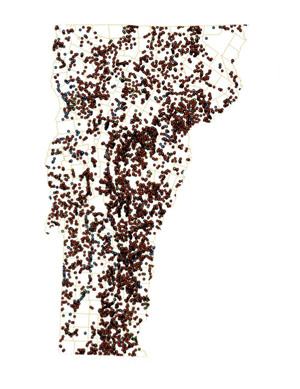How can we avoid blown out culverts, road washouts, and damaged buildings? Planning ahead can ensure that your community builds and expands infrastructure with flood readiness in mind. Ideally, "flood ready" means built in a safe location, away from hazardous floodplain areas. For existing infrastructure already located in floodplains, it means making smart investments to minimize future damage when river flows rise.
Video: What Went Right: A Culvert Tested by Irene
This culvert was designed to be compatible with the brook and then it faced Irene. This 10 minute video by Riverbank Media for he Connecticut River Conservancy (CRC) and the Conservation Law Foundation (CLF) looks at the design of the culvert to cross the Jenny Coolidge Brook in the Green Mountain National Forest (GMNF).
 All communities face flooding challenges. The dots on this map show where public assistance was provided for some of the recovery cost. Communities pick up the rest of the tab, which could be hundreds of thousands of dollars. This site can help you prioritize your improvements and avoid a recovery bill that you can’t afford.
All communities face flooding challenges. The dots on this map show where public assistance was provided for some of the recovery cost. Communities pick up the rest of the tab, which could be hundreds of thousands of dollars. This site can help you prioritize your improvements and avoid a recovery bill that you can’t afford.
Links to sections below:
- Adopt the 2013 Municipal Road and Bridge Standards
- Prepare a Local Hazard Mitigation Plan
- Improve Roads and Culverts to Withstand Flooding
- Adapt or Relocate Buildings and Critical Infrastructure
- Get Funding
Orange Book with the 2013 Road and Bridge Standards
 The Vermont Agency of Transportation (VTrans) has put together town road and bridge standards to improve safety, reduce life cycle costs, and reduce environmental impacts. If your community adopts standards that meet or exceed the ones laid out by VTrans, you can receive funding to improve your infrastructure before a flood event and get more state funds to meet your recovery costs if disaster does strike. Learn more about adopting the Orange Book Standards.
The Vermont Agency of Transportation (VTrans) has put together town road and bridge standards to improve safety, reduce life cycle costs, and reduce environmental impacts. If your community adopts standards that meet or exceed the ones laid out by VTrans, you can receive funding to improve your infrastructure before a flood event and get more state funds to meet your recovery costs if disaster does strike. Learn more about adopting the Orange Book Standards.
Prepare a Local Hazard Mitigation Plan
 Developing a Local Hazard Mitigation Plan (LHMP) helps you prioritize actions to avoid risks facing your community. For instance, your LHMP may identify a berm that places surrounding structures at risk and needs to be removed. An approved LHMP also gives you access to FEMA grants such as the Hazard Mitigation Grant Program, Flood Mitigation Assistance, and the Pre Disaster Mitigation Competitive grant. These programs provide up to 75% of the cost for flood-proofing public buildings, replacing culverts, and other projects that reduce your risk in the FEMA Special Flood Hazard Area. Learn more about preparing an LHMP.
Developing a Local Hazard Mitigation Plan (LHMP) helps you prioritize actions to avoid risks facing your community. For instance, your LHMP may identify a berm that places surrounding structures at risk and needs to be removed. An approved LHMP also gives you access to FEMA grants such as the Hazard Mitigation Grant Program, Flood Mitigation Assistance, and the Pre Disaster Mitigation Competitive grant. These programs provide up to 75% of the cost for flood-proofing public buildings, replacing culverts, and other projects that reduce your risk in the FEMA Special Flood Hazard Area. Learn more about preparing an LHMP.
Improve Roads and Culverts to Withstand Flooding
Communities face road washouts every year, sometimes isolating residents and businesses from work, school, and emergency services. This happens in river corridors, but also on hillsides as water channels are overwhelmed. Installing appropriately sized culverts is one of the best investments a community can make in their road system. The Local Hazard Mitigation Plan can help you prioritize the right investments and get you the funding you need. Learn more about culvert and road improvements.
Adapt or Relocate Buildings & Critical Infrastructure
The best way to keep buildings and infrastructure safe is to be smart about their location. Protecting the areas up and downstream of your town center that slow down and store floodwaters is critical. Moving buildings out of especially hazardous locations may be prudent. For those buildings and other infrastructure that can’t be moved, there are steps you can take to help them experience less damage in the next flood.
Get Funding
Finding funds to make infrastructure more flood-ready can be challenging. By adopting the Vermont Agency of Transportation Orange Book Standards and developing a Local Hazard Mitigation Plan, your community will qualify for funding to help invest in properly sized culverts and other upgrades that will keep your roads and buildings sound when it pours. See a full list of funding opportunities for reducing your risk of flood damage.
Vermont Community Example: Preparation in Pawlet
Learn how Select Board member and Road Commissioner Clarence Decker helpfed improve Pawlet's flood resilience through grant writing.






